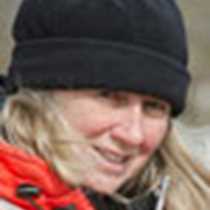October 19, 1805: Captain William Clark noted "a rock in a Lar'd bend resembling a hat". Once stately in its isolation, the hat now sits as a backdrop for a rapidly developing community. But even when progress intervenes, the character of the land still endures. We can erase the evidence of the modern day world and look at these forms with the eyes of explorers of long ago. How did they explain its origin? Did they know that molten magma poured forth to frost the rocks of ancient terranes and hide them from view? How did they explain these sculpted forms? As they paddled through turbulent rapids below, could they even have imagined the volume of water that roared through the same course tearing at blocks of basalt like the fingers of an enraged sculptor and leaving strange shaped buttes and mesas?
Further upstream, at Wallula Gap, a matched pair of buttes is silhouetted against the sky, sentinels looking north to a broad expansive plain and south to a narrow slot, a water gap through the folded lava flows. Maps call them "The Sisters" but long ago the men of the Corps of Discovery saw much more. They saw their Captains, Lewis and Clark, individuals but united in purpose and complementary in style just as the rocks were separate but joined.




